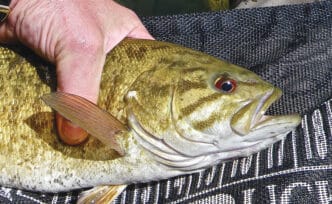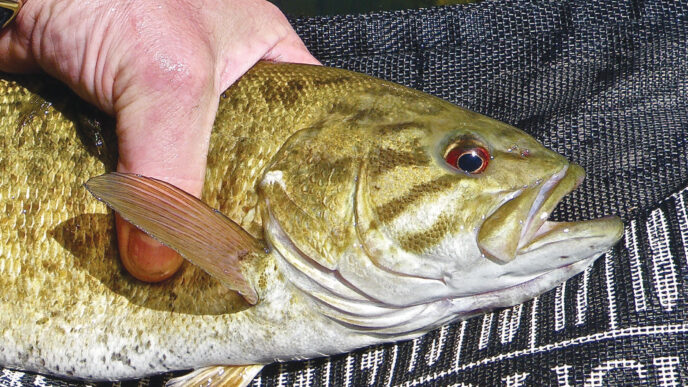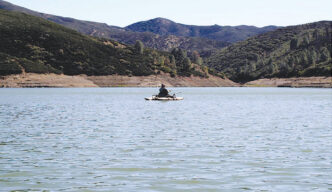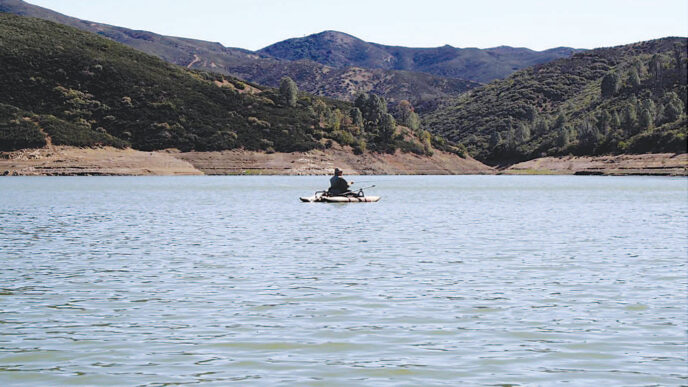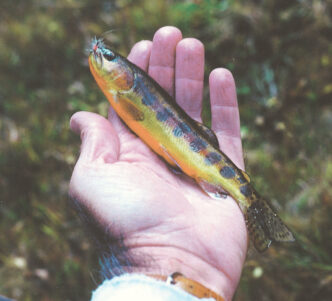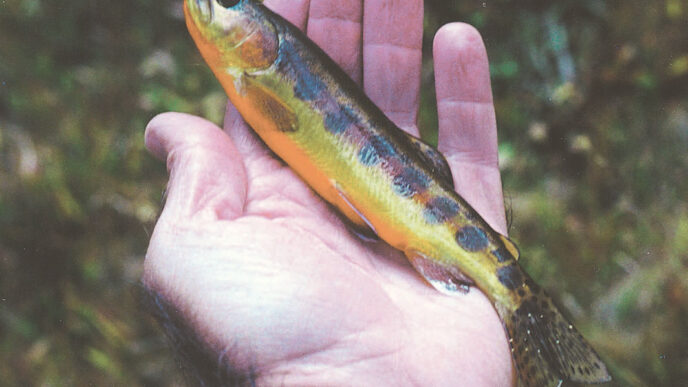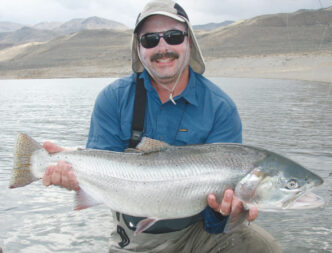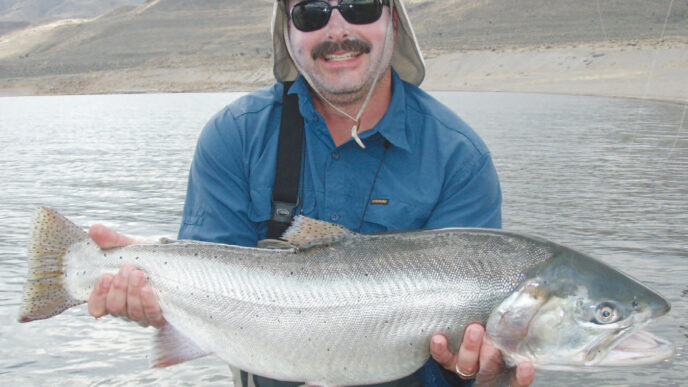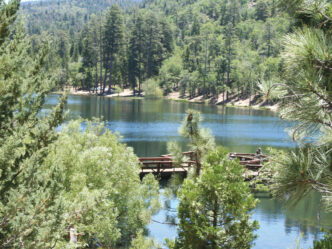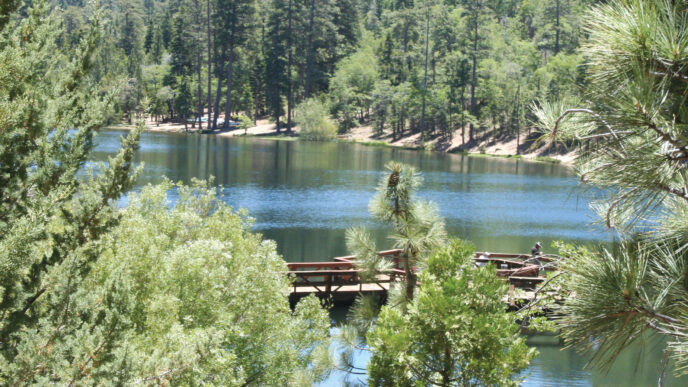I doubt that there is a hiker or other lover of the wilderness in the West who hasn’t had a bear encounter. Likewise, I suspect that there has not been a campfire circle under the Sierra or Coast Range stars without a bear tale or two. The California Department of Fish and Game recognizes two subspecies of resident black bear in the state: the California black bear, Ursus americana californiensis, and the northwestern black bear, Ursus americana altifrontalis. Not all are black. Honey, cinnamon, plain brown, and silvertips are common variants. Thirty thousand black bears are estimated to live in California, mostly above 3,000 feet. These magnificent wild creatures are rarely a grave threat, but they can be a nuisance that can turn a camping outing into an unpleasant or even frightening event. That same bear’s relatives are capable of ransacking a mountain cabin or destroying a vehicle that was left unattended with a week’s groceries on the back seat.
Bears and Humans
Bear lore goes way back. Jean Auel’s saga of early humans in prehistoric Europe during the last ice age starts with her first novel, The Clan of the Cave Bear. Cave bears dwarfed contemporary North American grizzlies, brown bears, and our own black bears. They were immense and a huge threat to these early peoples.
The Vikings revered bears and prepared for battle by donning bear skins. They worked themselves into a frenzy and believed that they assimilated the power of this magical beast and were invincible. We get the term “berserk” from these tales.
Closer to home, Native Americans had to deal with California grizzlies, as well as with black bears. Bears were featured in their creation stories, and in the Native American scheme of things, in which spiritual power is seen to reside in all creatures, “the Bear is always a good sign and a special power,” Bobby Lake-Thom writes in Spirits of the Earth. “He represents wisdom, insight, introspection, and healing. If you see a Bear while hiking in the woods or along the river, then you know that a very sacred place is nearby and that the spirits of that area are checking you out. Respect the Bear and don’t intimidate it, pray and give thanks to it, and make a special wish.”
When the Spanish first set eyes on what was to become California in the 1500s, grizzly bears were the top predator. They were very numerous. An abundance of salmon, game such as bison, deer, antelopes, and elk, and huge crops of acorns and berries supported large populations of bears at a time when animal populations lived in a harmonious balance with California Native Americans. It was the Spanish immigrants who upset the balance. With an increasing human population that encroached on the wilderness, encounters with bears become more frequent. The Spanish also brought cattle, which rang the dinner bell for the bears. However, grazing and the inadvertent introduction of Mediterranean annual grasses probably did more to decimate the bear populations than the poison, traps, and rifles used against predatory bears.
By 1900, 50 years after the Gold Rush and an influx of more immigrants, grizzlies in California were extinct. It’s a sad day when a species disappears by means other than natural processes, but a large grizzly population and today’s human population wouldn’t have been compatible. It’s tough enough to have your domestic cat or dog being threatened by coyotes. Imagine roaming grizzlies looking for a meal. You can’t go back.
Our resident black bears, however, have survived. Ann Bryant, the Tahoe Bear Lady, who lectures for The Bear League, says that this is because black bears instinctively tend to run and hide from threats, while grizzlies will confront and attack. She goes on to say that Oregon, Idaho, and California black bears are a subspecies that is less aggressive than black bears in other parts of North America. However, bears that are fed or find human or pet food regularly lose their fear and become problem animals. Often the problem bear is euthanized.
Dealing with Bears
It’s that innate timidness that is the foundation of successfully dealing with black bears at your mountain cabin, on the stream, or when nestled into a comfy campground. Most black bears will run when confronted by a human who raises his or her arms, stands tall, and shouts. Boat horns also can send a message. Throw a stone or a pinecone if the opportunity presents. But be sure to give these bears an escape route. A bear will sometimes, on very rare occasions, bluff-charge an intruder by running at its antagonist and stopping short. Authorities say that you are better off if you stand and make a large profile and disturbance, rather than running, so when you meet a bear, don’t panic and run. They are much faster than you. The California Department of Fish and Game lists only 12 bear attacks since 1980. Details were not always completely known, but officials did not list any fatalities. Still, when you meet a bear, give the bear a way and a reason to retreat.
Better yet, there are many things you can and should do to avoid confrontations with bears. Beyond the wisdom of not messing with a sow bear and cubs in any way, it all starts with food. Bears are attracted to and relish the same things we do. Like us, they love salt, fat, chocolate, and ice cream, although their definition of food also includes toothpaste, lotions, pet food, bird seed, diapers, candy bars, gum, and anything with a sweet smell. They are constantly searching for food using their superlative sense of smell. They are surprisingly intelligent and can recognize food sources such as coolers, food boxes, and Safeway grocery bags. They have good memories and will return to areas where they have been lucky in their foraging rounds. They are good tree climbers, can open unlocked car doors, and will use their strength to rip open any door or container into which they can get their teeth or long claws.
I had a truck camper shell broken into simply because I left an empty cooler in sight. The same bear shredded a garbage bin going after a fish carcass put there by a guest who thought he was being helpful in kitchen clean-up. At our Tahoe cabin, my wife and I now freeze food-related waste and put it in the bin the morning of garbage pickup. We also now have supposedly bearproof steel bins with supposedly bear-proof latches, which recently became mandatory in the Tahoe basin. The “bear-proof ” latches had to be modified, however, because it took the bears only two months to figure out how to jimmy the locks. Even now, bears run a route at night, hoping that they will find a bin where a careless guest hasn’t turned the locking mechanism all the way shut. They hit the door with their arm and claw, knowing that an incomplete closure may pop open. A four-hundred-pound bear can give a bin a real good pop. It wakes you up when it happens, usually around 2:15 in the morning. Bears have good internal clocks and know when most lights are out, activity is over, and even teenagers have gone to bed.
At Independence Lake, north of Truckee, a six-hundred-pound black bear ripped open the back lid of a new Chevrolet Suburban with fresh groceries in sight. The repair bill was $,1400. The owner had just returned from a Reno Costco and had jumped out of his vehicle to use the campground restroom. A friend who lives in Tahoma on Tahoe’s west shore left his doors unlocked after a grocery-buying trip and went inside his cabin to take a phone call. An opportunistic neighborhood bear invited himself into the car. He started with the ice cream, went on to pancake syrup, then strawberries, and destroyed the upholstery before eating his fill and leaving.
These bears were animals that were hungry, had gotten a taste and habit of human food, and recognized opportunities. They break into houses because they know that refrigerators have five-star gourmet ratings and that kitchen pantries have treats. Bird feeders and pet food are at high risk, too. Single-pane windows in cabins increase the risk quotient, as do sloppy housekeeping and vehicles with cracker crumbs and potato chips between the seats.
Bears also are foraging anglers. We have a year-round creek on our property. In the springtime and fall, when rainbows and brown trout make their spawning runs up the waterway, bears go fishing.
It’s worse at a cabin, summer home, or campground when unknowing visitors looking for photo ops feed the bears. These bears become aggressive and resolute. They aren’t vindictive and don’t get mad or violent, but can be very hard to drive away. They know little fear, because it is illegal to shoot one unless it is in your house. My dad and I were lakeside camping at Blue Lakes, south of Highway 88, a few years ago. This area was known for its bear problems, but we weren’t aware of how bad it was. Bears came into our camp in broad daylight while we were cooking dinner. Shouting and a slingshot did no good, but running at them while banging on a big pot with a stick did. Like anglers who had put down feeding trout, they would rest you for a while and then, when you went back to eating, return for another try. After our meal, I did the dishes, gathered the garbage, and walked at last light to the camp garbage bins. I thought I saw a woman ahead of me dumping her bags into the container. When I spoke and approached, the “lady” rose up on hind legs and snarled. I was disturbing her dinner, just as she had disturbed mine.
We couldn’t run the bears off, so we decided to sleep inside my camper shell and put our cooler in the locked front cab. Late-arriving campground neighbors were camping out of open jeeps. I warned them, and they put their food boxes and coolers on the jeep rear decks and strapped them down with bungee cords. They had a good party and hunkered down in the open campsite in sleeping bags sometime past midnight. The bears never disturbed a hair on their heads, but their jeep interiors were ripped beyond belief, and their gear was trashed. My dad and I packed up the next morning and drove to Davis Lake, very tired of dealing with an unsolvable problem.
In camp, be very careful about food that will attract a bear. Some campgrounds are extremely vulnerable. Camp hosts can give you an assessment of risk, but in the mountains, I assume that a prowling bear is always a possibility. Wash your dishes after every meal and take your garbage to a safe disposal site. Don’t overfill dumpsters or stack garbage outside a container. The scent of Pine Sol can act as a bear deterrent, so if bear-proof containers are not present, spray Pine Sol in every garbage bag before putting it out and don’t bet on it working as a deterrent all the time. Do not take food of any type into a tent. Don’t tuck a snack into your sleeping bag. Clear your table of all food.
The first choice for food storage is a metal bear-proof bin. Some campsites have them, but not many. You can cache food in a bundle suspended from a tree with a rope, but remember that bears are smart. Do a good job. Many bears recognize the yellow polypropylene rope that is often used to hang food sacks. Numerous backcountry campers have lost their caches to crafty animals. Storing food in a locked vehicle cab can be a good idea, particularly if you put a dish of Pine Sol on the front seat. Keep your coolers and camp clean and close your vehicle’s windows. I like to seal meat in cryovac packaging. It’s always a good idea from the food-safety standpoint and lessens odors. Wipe out your cooler with a little ammonia every day.
One of the reasons that many of us chase wild fish is to see Mother Nature’s creatures in natural surroundings. As Bobby Lake-Thom says in Spirits Of The Earth, bear sightings in the wild are a special thing. It’s only occasionally in camp that they are a nuisance, much less a deadly threat. The animal should be respected, and that starts by doing your part to keep interactions with bears from becoming problems for humans and bears alike.
California Porters
If you’re a fan of dark beers, as am I, you might want to know that five of the top ten porters reviewed recently by the New York Times are from California, specifically: Speakeasy Payback Porter, Sierra Nevada Porter, Mad River Steelhead Scotch Porter, Firestone Walker’s Reserve, and Eel River Porter. Impressive!
Richard Anderson







